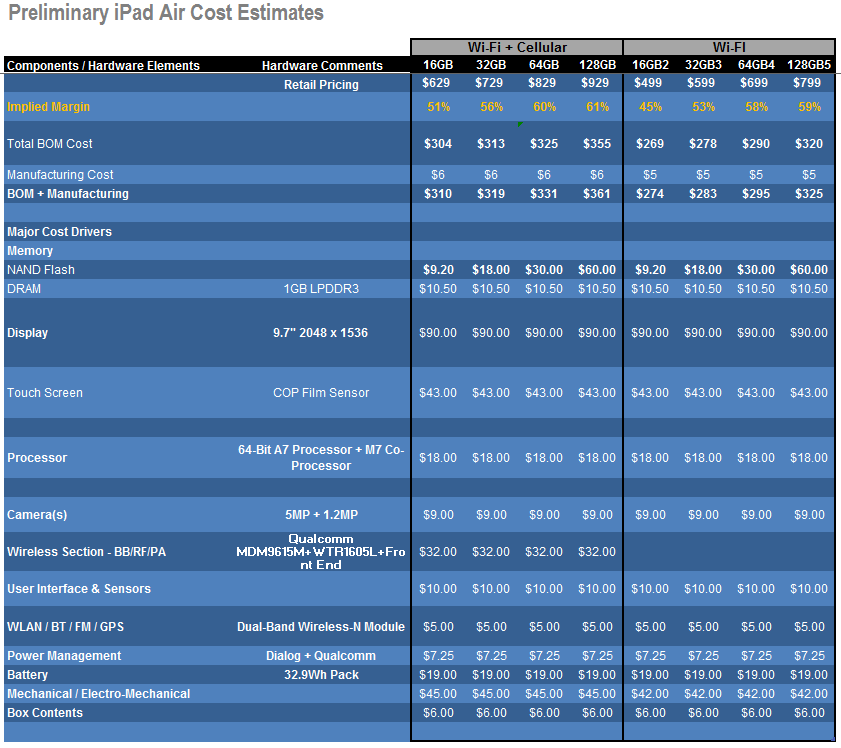A new report from IHS breaks down iPad Air's components to reveal that the new product costs are actually much lower, and the company might be getting a much fatter profit. However, costs for iPad Air display has actually gone up, despite a cutback on LEDs for backlight. The lighter weight requirement has raised subsystem prices. IHS analyst Andrew Rassweiler told AllthingsD reporter, that the new iPad Air has used optical film to help distribute light better and cut down product weight. A new type of sensor known as a cyclic-olefin polymer sensor has also been introduced and placed underneath the outer layer of Gorilla Glass that users touch, the report noted. Below are excerpts from the IHS press release:
The iPad Air with 16 gigabytes (GB) of NAND flash memory and cellular connectivity has a BOM of US$ 304, according to preliminary results from the Teardown Analysis Service at IHS Inc.. This represents a 6 percent reduction from US$ 325 for an equivalently equipped third-generation iPad, based on a final pricing estimate for the device at the time of the release in 2012.
When the US$ 6 manufacturing cost of the iPad Air is added in, the total cost to make the tablet increases to US$ 310.
For the lowest-end iPad Air model with 16GB of NAND and no cellular connection, the BOM and manufacturing cost is US$ 274, US$ 42 less than the entry-level third-generation iPad.
“While the iPad Air slims down in size, the profit margins are getting fatter,” said Andrew Rassweiler, senior director, cost benchmarking services for IHS. “Although the Air’s new, ultrathin display and touch screen are more expensive than for the third-generation iPad, Apple has held the line on cost by taking advantage of price erosion in other areas. Furthermore, the iPad Air leverages the same components and suppliers that are used in the iPhone 5s and 5c as much as possible.”
The profitability of the iPad Air rises dramatically as the NAND memory capacity increases. For example, the 32GB model costs Apple only US$ 8.40 more to produce—but has a retail price that’s US$ 100 higher.
 |
|
Table 1 attached presents the preliminary BOM and manufacturing cost estimate of the iPad Air based on a physical teardown of the tablet. Note that the teardown assessment is preliminary in nature, accounts only for hardware and manufacturing costs, and does not include other expenses such as software, licensing, royalties or other expenditures. (Courtesy of IHS) |
iPad slims down on display diet
The iPad Air’s thinner form factor is partly due to reductions in the thickness of the display and touch-screen subsystems.
The Air’s display is 1.8 millimeters (mm) thick, compared to about 2.23 mm for the older-generation iPad. Meanwhile the touch screen is also thinner with its use of an expensive cyclo olephin polymer (COP) film sensor vs. the thicker and cheaper glass sensor used in the previous models.
However, such svelteness comes at a price, with both subsystems more costly than before.
The iPad Air’s display carries a cost of US$ 90, compared to US$ 87 for the third-generation model. The touch-screen module is estimated at US$ 43.00, compared to US$ 37.50 for the third-generation iPad.
Electricity is in the Air
Interestingly, Apple has reduced the capacity of the battery in the iPad Air compared to the previous iPad. Battery capacity in the iPad Air is 32.9 watt hours (Wh), down 23 percent from 42.5Wh in the third-generation model.
This is most likely because of lower power consumption in the display backlight. The iPad Air uses only 36 light-emitting diodes (LED) to illuminate the liquid-crystal display (LCD), down from 84 in the earlier-generation iPad. Fewer LEDs results in lower electricity demand, allowing the cut in battery power.
 |
|
Apple's iPad Air deconstructed into separate components. (Courtesy of IHS) |





 CN
TW
EN
CN
TW
EN






